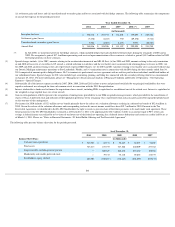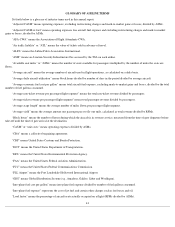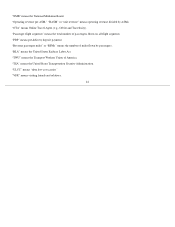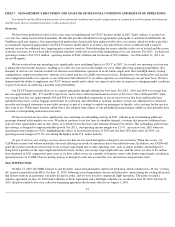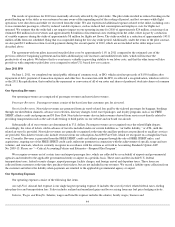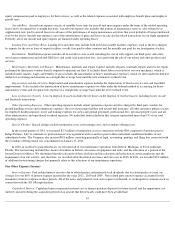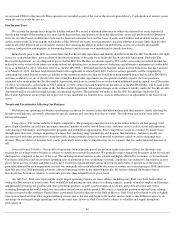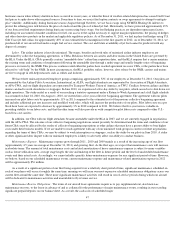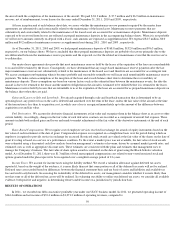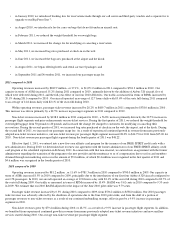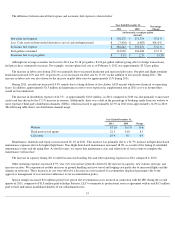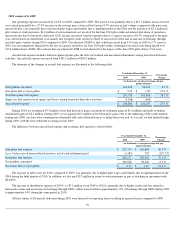Spirit Airlines 2011 Annual Report Download - page 56
Download and view the complete annual report
Please find page 56 of the 2011 Spirit Airlines annual report below. You can navigate through the pages in the report by either clicking on the pages listed below, or by using the keyword search tool below to find specific information within the annual report.
During the fourth quarter of 2010, the Company determined not to renew its agreement with the administrator of the FREE SPIRIT affinity
credit card program at the scheduled expiration in February 2011. We entered into a new affinity card program that became effective April 1,
2011 for the marketing of a co-branded Spirit credit card and the delivery of award miles over a five-year period. At the inception of the
arrangement, we evaluated all deliverables in the arrangement to determine whether they represent separate units of accounting using the criteria
as set forth in ASU No. 2009-13. We determined the arrangement had three separate units of accounting: (i) travel miles to be awarded, (ii)
licensing of brand and access to member lists, and (iii) advertising and marketing efforts. Under ASU No. 2009-13, arrangement consideration
should be allocated based on relative selling price. At inception of the arrangement, we established the relative selling price for all deliverables
that qualified for separation. The manner in which the selling price was established is based on a hierarchy of evidence under ASU No. 2009-13
that we considered. Total arrangement consideration was then allocated to each deliverable on the basis of the deliverable's relative selling price.
In considering the hierarchy of evidence, we first determined whether vendor-specific objective evidence of selling price or third-party evidence
of selling price existed. We determined that neither vendor-specific objective evidence of selling price nor third-
party evidence existed due to the
uniqueness of our program. As such, we developed our best estimate of the selling price for all deliverables. For the selling price of travel, we
considered a number of entity-specific factors including the number of miles needed to redeem an award, average fare of comparable segments,
breakage, restrictions, and fees. For licensing of brand and access to member lists, we considered both market-specific factors and entity-
specific
factors, including general profit margins realized in the marketplace/industry, brand power, market royalty rates, and size of customer base. For
the advertising and marketing element, we considered market-specific factors and entity-specific factors including, our internal costs (and
fluctuations of costs) of providing services, volume of marketing efforts, and overall advertising plan. Consideration allocated based on the
relative selling price to both brand licensing and advertising elements is recognized as revenue when earned and recorded in non-ticket revenue.
Consideration allocated to award miles is deferred and recognized ratably as passenger revenue over the estimated period the transportation is
expected to be provided (historically estimated at 15 to 20 months and currently estimated at 16 months). We used entity-specific assumptions
coupled with the various judgments necessary to determine the selling price of a deliverable in accordance with the required selling price
hierarchy. Changes in these assumptions (e.g., cost of fare, number of miles to redeem awards, marketing plan, and approval rate of credit cards)
could result in changes in the estimated selling prices. Determining the frequency to reassess selling price for individual deliverables requires
significant judgment. During 2011
, the Company changed the expiration of its award miles from six months to three months, which resulted in a
reduction of the estimated period the transportation is expected to be provided from 20 months to 16 months. The change increased revenues by
$0.2 million in 2011. For additional information, please see “Notes to Financial Statements—1. Summary of Significant Accounting Policies—
Frequent Flier Program”.
Aircraft Maintenance, Materials, Repair Costs and Related Heavy Maintenance Amortization. We account for heavy maintenance under
the deferral method. Under the deferral method the cost of heavy maintenance is capitalized and amortized as a component of depreciation and
amortization expense until the next such heavy maintenance event. Amortization of engine and aircraft overhaul costs was $2.6 million, $1.3
million and $1.0 million for the years ended December 31, 2011 , 2010 and 2009 , respectively. If engine overhaul costs were amortized within
maintenance, material and repairs expense in the statement of operations, our maintenance, material and repairs expense would have been $38.1
million, $29.5 million and $28.5 million for the years ended December 31, 2011 , 2010 and 2009 , respectively. During the years ended
December 31, 2011 , 2010 and 2009 , we capitalized $22.1 million, $5.2 million and $5.3 million of costs for heavy maintenance, respectively.
The next heavy maintenance event is estimated based on assumptions including estimated usage, FAA-mandated maintenance intervals and
average removal times as suggested by the manufacturer. These assumptions may change based on changes in our utilization of our aircraft,
changes in government regulations and suggested manufacturer maintenance intervals. In addition, these assumptions can be affected by
unplanned incidents that could damage an airframe, engine, or major component to a level that would require a heavy maintenance event prior to
a scheduled maintenance event. To the extent our planned usage increases, the estimated life would decrease before the next maintenance event,
resulting in additional expense over a shorter period. Heavy maintenance events are our HMV4 and HMV8 airframe checks, engine overhauls,
and overhauls to major components. Certain maintenance functions are outsourced under contracts that require payment based on a performance
measure such as flight hours. Costs incurred for maintenance and repair under flight hour maintenance contracts, where labor and materials price
risks have been transferred to the service provider, are accrued based on contractual payment terms. Routine cost for maintaining the airframes
and engines and line maintenance are charged to maintenance, materials and repairs expense as performed.
Maintenance Reserves
. Our master lease agreements provide that we pay maintenance reserves to aircraft lessors to be held as collateral in
advance of our performance of major maintenance activities. These lease agreements provide that maintenance reserves are reimbursable to us
upon completion of the maintenance event in an amount equal to the lesser of (1) the amount of the maintenance reserve held by the lessor
associated with the specific maintenance event or (2) the qualifying costs related to the specific maintenance event. Substantially all of these
maintenance reserve payments are calculated based on a utilization measure, such as flight hours or cycles, and are used solely to collateralize
the lessor for maintenance time run off
49


